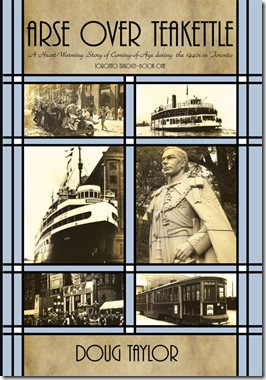The following excerpt is from “Arse Over Teakettle,” a story about a family struggling to cope with the difficulties of the war years in Toronto. The main character of the book is a young boy, Tom Hudson, who is eight years of age when the war ends. My previous post told about the event through the eyes of this fictional character. This post describes the events in downtown Toronto, when the news reached the workers in the offices and shops that after six long years, the conflict in Europe had ceased.
The hostilities had not completely ended, as the war in the Pacific continued. However, the citizens of Toronto were confident that the fighting would soon end over there as well. Canadians were exhausted from the daily newspaper lists of the names of those who had been killed and the radio reports of the battles, Torontonians went wild in their celebrations as they looked forward to their loved ones returning home, the end of food rationing, and a return to the days of peace.
The following excerpt tells about the events in downtown Toronto on that all-important day in May of 1945.
On this morning of mornings, Tuesday, 8 May 1945, young boys feverishly hawked early editions of the newspapers, swarming streets, offices, hotels, factories, shops, and restaurants. Security staff at the Royal York Hotel smiled tolerantly as they removed the lads from the prestigious lobby. A few elderly guests hoped for a return to silence as they reclined in the plush chairs beneath the ornate ceiling and scanned their newspapers. They glanced disapprovingly at the youthful clerks behind the desk, who were laughing and hugging each other.
For the young employees, it was the most important moment of their lives. The extra-large letters of the headline said it all: Unconditional Surrender—the words occupying the entire top half of the front page. Everyone was in the mood to celebrate. After five years, eight months, and six days, the long-awaited miracle had materialized. On the street outside the hotel, unlike in the hotel lobby, pandemonium had already erupted.
People poured from buildings, crowds flowing into the streets and avenues. Fear of losing jobs because they had abandoned work was considered unimportant compared to the desire to celebrate. The Toronto Stock Exchange, which had opened at 10:00 a.m., closed at 10:45 a.m. In office buildings, workers grabbed any paper within reach and tossed it out the windows. In the streets below, the paper inundated the avenues like a snowstorm.
When employees descended to street level, they saw that automobiles were motionless and drivers stymied. Bedlam reigned supremely. Streetcars were trapped among the shouting, dancing, flag-waving throngs. Individuals improvised their own ways to celebrate. Three sailors smeared generous amounts of lipstick on their grinning mouths, marched arm-in-arm, and danced the can-can as they pranced northward up Yonge Street.
An elderly air force veteran imitated “Herr Hitler” as he goose-stepped with a washbasin on his head, a finger under his nose to imitate the mousy moustache. Young women grabbed sailors in uniform and kissed them fervently. The service men did not object to being outrageously molested. It was nice to know that being “politically correct” was not always necessary.
A policeman attempted to restrain the crowd only to have his white-gloved hand grasped by an elderly woman and kissed repeatedly. Five motorcycle cops gave up, parked their vehicles, and stood on the seats as they shouted and waved. Groups of young men climbed on the roofs of the streetcars and festooned the trolley wires and poles with the ticker tape that the jubilant workers had thrown from office windows. Paper drifted across the streets in billowing waves. On the east side of Yonge Street, it was knee deep. Just when people thought that the flood of ticker tape had slowed, another deluge of orange paper descended, its source a mystery. Yonge Street between Front and King Streets was the “confetti belt.” The hydro pole in front of 86 Wellington St. East became the most decorated in the city. No one knew why. It almost appeared to sag under the weight of the white streamers while celebrants danced around it singing, “It’s a Long Way to Tipperary.” The following day, people inquired if it had been the address of a liquor store, but it had not.
Shortly before the noon hour, two parades—one on Bay Street and another on Yonge, both several blocks in length—spontaneously marched toward City Hall. The Bay Street parade lustily sang a throaty rendition of “Roll out the Barrels.” It was as if an unseen hand had choreographed the musical extravaganza. Within five or ten minutes, the space in front of the civic building was filled to capacity and beyond. The cenotaph was a granite ship amid a seething sea of humanity. A small group of inebriated sailors chorused enthusiastically:
Hail, hail, the gang’s all here.
What the hell do we care?
We still have our underwear.
Hail, hail the gang’s all here.
What the hell do we care now?
The riotous song was soon drowned by the music blaring from the loudspeakers mounted on the stage at the top of the city hall steps, playing the song “Anchors Aweigh.” The crowd reluctantly parted when a torchbearer arrived, descended from the top of the stairs, and ignited an improvised victory flame beside the cenotaph. The shouting momentarily stopped as Mayor Saunders delivered a short address and then pleaded with workers to return to work. However, his pleas were ignored. The crowds were in no mood to wait. They joyously continued singing and dancing. The mayor’s voice was drowned out as he announced that the following day, Tuesday, 8 May, would officially be a holiday—V-E Day. The celebrations had already begun.
